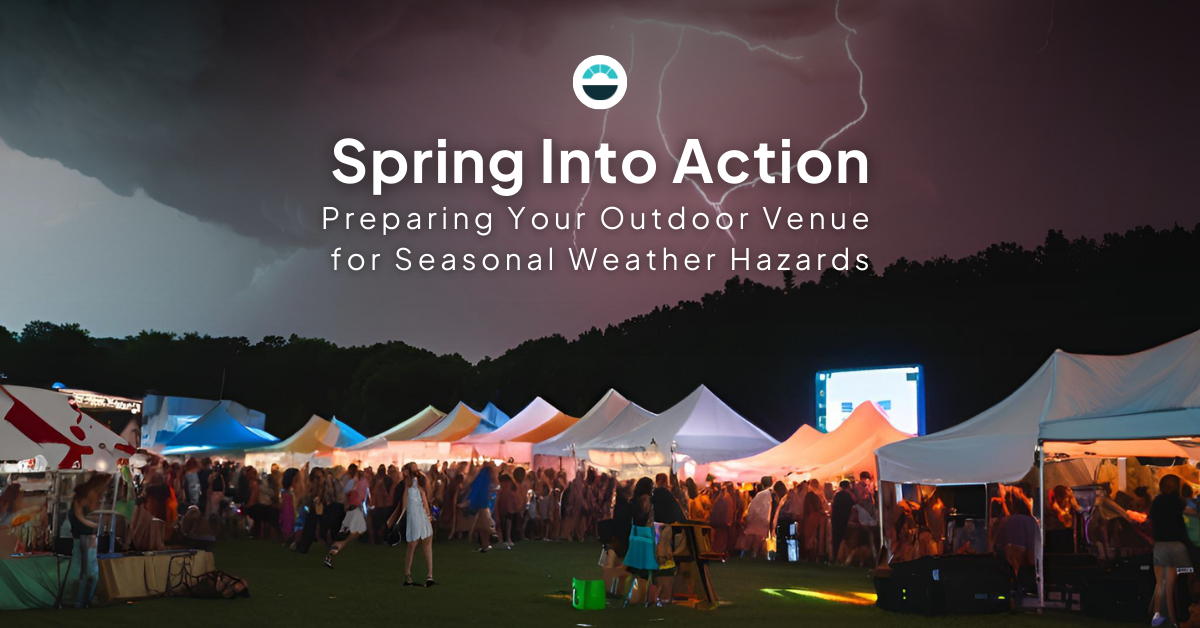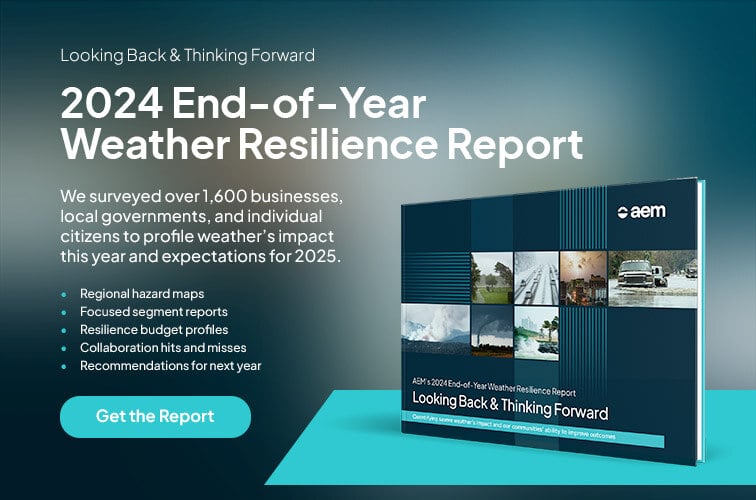
As winter loosens its grip, more and more people are shaking off the cold and heading outside for live music, festivals, sports, and all kinds of outdoor events. With the warmer weather comes a noticeable spike in attendance at outdoor venues—but it also brings a new set of challenges.
From scorching heat and surprise storms to poor air quality, outdoor event spaces have to be ready for just about anything. And while regional weather forecasts offer a general outlook, they often miss the real-time, hyper-local shifts that can happen just a few miles apart. That’s why venues need more than just a heads-up—they need a proactive safety strategy that includes live environmental monitoring and clear, actionable protocols to keep everyone safe and the show running smoothly.
In what follows, we'll examine:
- The high stakes involved with outdoor events and weather risks
- The top weather risks facing spring and summer events outside
- Best practices for managing weather risk
- The sudden and hyperlocal nature of weather
Outdoor events: A season of high attendance, high stakes
As warmer weather arrives, millions of people head outdoors for concerts, festivals, sports, fairs, and recreational activities. The sheer scale of participation underscores why venues must be prepared for natural hazards:
-
The outdoor recreation participant base grew to 175.8 million people in 2023—more than 57% of all Americans over age six.
-
The world’s top 25 theme parks saw a 23.5% increase in attendance in 2023, welcoming 244.6 million guests.
-
In a single year, 32 million people attended at least one U.S. music festival, according to Nielsen Music.
-
Even the Illinois State Fair saw record-setting attendance in 2023, with more than 700,000 visitors over 11 days.
With attendance at outdoor events surging, so too does the responsibility of venues to keep guests safe from extreme heat, storms, poor air quality, and other environmental hazards. When these hazards are allowed take guests by surprise, events that were supposed to be fun and joyous can quickly turn tragic and deadly. Here are just a few recent examples:
Nearly 100 people were injured in June 2023 when a hail storm broke out at Colorado's Red Rocks Ampitheater ahead of a planned Louis Tomlinson concert.
In June 2021, a New Jersey man died after being struck by lightning while playing golf at a local country club. The lightning was part of a highly localized thunderstorm.
One person died and about 20 were injured after high winds at a music festival in Spain caused part of the stage to collapse in August 2022.
On November 17, 2023, a 23-year-old woman collapsed while attending a Taylor Swift concert at Nilton Santos Stadium in Rio de Janeiro, Brazil. She was later pronounced dead from cardiac arrest brought on by heat exhaustion. Although November is considered spring in the Southern hemisphere, the day brought extreme temperatures reaching 102°F (39°C) and a heat index of 138°F (59.3°C).
Four people were injured after a small tornado hit a campsite at a German music festival, sending tents and other debris into the air. Their injuries stemmed from the flying debris.
In the wake of Canada's historic wildfires of 2023, organizers made the necessary decision to cancel outdoor activities to protect kids against dangerously poor air quality.
Courts and juries have repeatedly demonstrated their willingness to hold organizers and venues accountable when reasonable precautions (like monitoring forecasts, warning attendees, pausing events, providing shelters/medical aid) are not taken. A single disaster can result in huge payouts:
- After a storm blew down the Dallas Cowboys' practice tent, paralyzing one coach and injuring about a dozen others, the team was ordered to pay out approximately $34 million in damages.
- After a thunderstorm with 60+ mph wind gusts collapsed stage rigging onto a crowd at the Indiana State Fair, the state and private defendants ended up paying out approximately $50 million in combined damages.
- After a 9-year-old boy was struck by lightning during a soccer practice, the family sued the local youth soccer league for $10 million and settled for an undisclosed sum.
The combination of attendee lawsuits, sizable settlements/judgments, and even criminal charges in extreme cases has sent a strong message. Today, major outdoor venues (stadiums, theme parks, race tracks, etc.) have detailed weather emergency plans, and many jurisdictions enforce safety codes for temporary structures (tents, stages).
Top natural hazards for spring and summer events
Now that we've established what's at stake, let's briefly review some of the most common natural hazards that outdoor venues and event organizers need to prepare for during the spring and summer months.
-
Extreme heat and heat-related illness
High temperatures, combined with large crowds, can lead to dangerous conditions. Risks include heat exhaustion, dehydration, and heat stroke. In addition to temperature, organizers should consider factors like humidity and lack of shade, which can make it feel even hotter.
-
Strong winds and wind gusts
Outdoor structures like tents, staging, and signage are vulnerable to sudden wind gusts. Flying debris or collapsing structures can injure guests.
-
Lightning
Deadly lightning strikes can occur miles ahead of an approaching storm, and they can happen with little or no warning. The sky may be clear and blue. By the time you hear thunder, you may already within the reach of lightning.
-
HAIL
Depending on your location and the severity of the storm, hail can range anywhere from the size of a pea to the size of a grapefruit -- usually somewhere in between. Anything over the size of a quarter is considered severe. Hail can easily inflict bumps and bruises on those who are exposed, and large hail can inflict potentially fatal head injuries.
-
Air quality
Outdoor air quality can fluctuate due to pollution, high ozone levels, wildfire smoke, and allergens. Poor air quality can cause respiratory issues, discomfort, and health concerns, especially for vulnerable guests.
-
Tornadoes
Although they can occur any time of year, tornadoes are most common in the spring and early summer. By their very nature, tornadoes are hyperlocal. Although the storm cells that produce them can be large, the actual path of the tornado ranges from as little as a few yards to a little over a mile wide. Yet, for those in the path, tornadoes can be some of the most destructive weather events known to humanity.
Best practices for managing weather risk
The American Meteorological Society (AMS) has identified six best practices that are commonly employed by event organizers and venues that successfully avert weather disasters. They are:
- Use a professional meteorologist to forecast and monitor the weather. We would add that forecasts and monitoring should be site-specific and/or event-specific to accommodate your unique needs and concerns.
- Identify appropriate staff to implement an integrated warning team. Utilize guidelines from the NOAA/NWS Weather-Ready Nation and/or StormReady programs.
- Utilize a decision tree that clarifies each person's responsibilities, and ensure a responsible person is in charge of maintaining situational awareness before, during, and after the event.
- Generate a weather plan in advance with clearly defined decision triggers for each weather risk in your portfolio. Have a process to routinely evaluate and update the plan.
- Designate the nearest safe structures, and allow enough time for guests to reach those structures.
- Implement clear communication mechanisms appropriate for each stakeholder group (e.g., organizers, local emergency management, guests, etc.), which should include a mass communication plan to communicate risk to guests.
Beyond these best practices, we at AEM would add that outdoor venues and event organizers need to consider the fact that many weather hazards can spring up suddenly and impact only a small area. Let's explore what that actually means.
The sudden and hyperlocal nature of weather
When we think of spring and summer weather hazards, many of us tend to picture large-scale systems that may be tracked for days at a time and can span across multiple states. But, most weather is not like that.
Many single-cell thunderstorms come with isolated but powerful updrafts capable of producing lightning, hail, tornadoes, and high winds. These isolated updrafts are more common and more intense during the early stages of a thunderstorm, which means they can hit with little warning. And they are highly localized, ranging from as little as 0.3 miles in diameter to as great as 2.5 miles.
We don't often think of heat as being highly localized, but it is. Try walking along a hilly road on a hot day. You'll often find that the air feels noticeably cooler when you reach the bottom of the trough between two hills. We may not think about it, but that phenomenon is a natural byproduct of the fact that warm air tends to rise as cool air sinks. And that difference gets compounded when you throw in the difference between shade and sunlight or the difference between being on asphalt and on a planted surface like grass.
Even air quality can be highly localized, as pollutants and allergens in the air get carried along by winds. While global wind patterns are large-scale and relatively predictable, local winds are influenced by highly localized geographic and atmospheric circumstances and can impact areas ranging from a hundred kilometers to just a few kilometers in size. As a result, areas within a few miles of each other can experience vastly different levels of air quality.
What this means is that an outdoor event could be impacted by weather that looks radically different than weather just a few miles away. And that weather could pop up suddenly with minimal warning. As a result, we would supplement the AMS's list of best practices with two others:
- Alerting should be based on forecasted conditions, not just current observations. Guests need to receive enough advance notice to seek shelter before they are harmed or endangered. By the time a weather event strikes, it is often too late to react. That's why some alerts need to be based on forecasted conditions.
- Weather monitoring should be site-specific. Regional forecasts on the television news are designed to cover a region as a whole and not one specific venue within it. Site-specific monitoring could involve having a professional meteorologist monitor weather conditions at your site. It may also need to extend to the deployment of weather stations and other sensors at your site to collect site-specific observations.
However, improving guest and worker safety (thereby reducing potential liability) is only one benefit of site-specific monitoring. Delaying or canceling an event due to bad weather can be extremely expensive, and site-specific monitoring can minimize false alarms. Just as it empowers organizers to more reliably anticipate when weather hazards will hit their venue, site-specific monitoring can enable them to better anticipate when those hazards are likely to miss.
Final thoughts: A season of safe and successful events
As outdoor activities ramp up, venues need a comprehensive plan to address natural hazards. Proactive monitoring, clear safety protocols, and real-time environmental data make all the difference in guest safety and operational success.
Now is the time to assess preparedness—before the season reaches full swing. By leveraging the right technology and best practices, venues can ensure a safe and enjoyable experience for all attendees, no matter what nature has in store.

